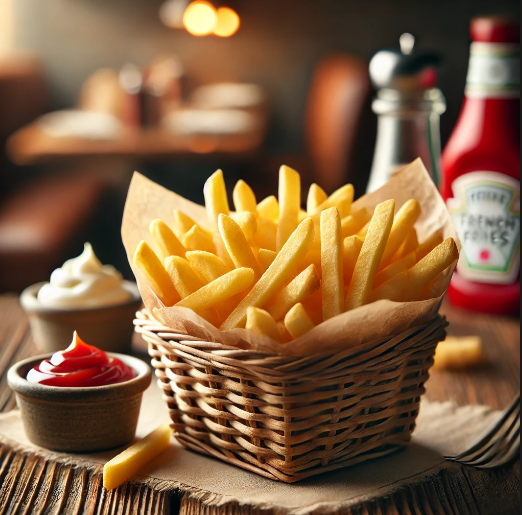French Fries Origin

The History and Evolution of French Fries

French fries are one of the most popular side dishes across the globe, often found paired with burgers, sandwiches, and even enjoyed as a standalone snack. But how did these crispy, golden strips of potato become such an integral part of global cuisine? The journey from their debated origins to their place in modern food culture is fascinating and filled with twists and turns. In this blog, we will explore the rich history, myths, and evolution of French fries, examining how this humble dish gained international fame.
The Origin Debate: Are French Fries Really French?
When it comes to French fries, one of the most persistent debates is whether they originated in France or Belgium. The French believe the origins can be traced back to the late 18th century in Paris. According to local legend, street vendors on the Pont Neuf bridge sold crispy, fried potato spears to passersby, which were appropriately named pomme Pont-Neuf after the bridge itself.
However, Belgium disputes this claim, pointing to the city of Namur as the birthplace of fries. Their story goes back to the winter of 1680, when the River Meuse froze over, preventing locals from catching fish. Instead of going without, they sliced potatoes into the shape of small fish and fried them, leading to what they claim as the first batch of fries. Despite this, historical evidence suggests that potatoes weren’t a significant part of the Belgian diet at that time, casting some doubt on the tale.
Whichever story you believe, it’s clear that French-speaking countries played a crucial role in the development of this beloved snack.
How French Fries Became a Global Fast Food Phenomenon
Though fries were popular in Europe, they truly skyrocketed in fame after crossing the Atlantic. Thomas Jefferson is often credited with bringing fried potatoes to America after serving them at the White House. His version of fries, pommes de terre frites à cru en petites tranches, were sliced in rounds rather than sticks, making them more like thick chips than the fries we know today.
It wasn’t until the early 20th century, with the rise of fast food chains like White Castle and McDonald’s, that French fries became a staple in American dining. In 1921, White Castle began pairing fries with their iconic sliders, laying the foundation for fries as the default side for burgers across the country. By the time McDonald’s expanded in the 1950s, fries were a must-have item on their menu. This combination of burgers and fries became synonymous with fast food, contributing significantly to fries’ global dominance.
The Influence of World Wars on French Fries’ Popularity
Surprisingly, both World War I and World War II played important roles in boosting the popularity of French fries, especially in the U.S. During World War I, American soldiers stationed in Belgium were introduced to pommes frites and quickly developed a taste for them. When they returned home, they brought the craving for fries with them, sparking a rise in demand.
In World War II, food shortages and rationing led to innovations in how potatoes were consumed. Due to a lack of cooking fat, Americans created alternatives like baked oven fries, which resembled their fried cousins but required less oil. Meanwhile, fries became an economical and filling side dish, making them a popular option during wartime and in the years following.
Fries Around the World: Different Variations and Cultural Takes
As French fries spread across the globe, different cultures adopted and modified them to suit their tastes, leading to many unique variations. In the UK, fries — known as “chips” — are most famously paired with fried fish, a combination that dates back to the 1860s. Fish and chips quickly became a favorite dish among the British working class and remains a cultural icon.
In Canada, French fries are a key ingredient in the beloved dish poutine, which features fries topped with cheese curds and gravy. In the U.S., fries are often served with ketchup, but regional variations can include chili cheese fries, garlic fries, and even loaded fries topped with bacon and sour cream.
Countries like India have taken a spiced approach to fries, adding chili powder, turmeric, and other seasonings to give them a unique flavor. Belgium, where fries are considered a national treasure, often pairs them with a variety of sauces, particularly mayonnaise.

Frequently Asked Questions (FAQs)
1. Why are they called “French” fries if they may have originated in Belgium?
The term “French” fries likely comes from the method of slicing the potatoes, which is called “frenching” — a culinary term that means to cut food into thin strips. This technique was widely used in France and may have influenced the name.
2. Did Thomas Jefferson really introduce French fries to America?
Yes, Thomas Jefferson is often credited with introducing fried potatoes to America after serving them at a White House dinner. However, his version was more like thick potato chips than the French fries we know today.
3. What is the difference between French fries and chips?
In the U.S., French fries refer to thin, crispy potato strips, while in the UK, “chips” are thicker-cut fried potatoes. The difference largely comes down to the country and its culinary traditions.
4. What are the healthiest types of fries?
Baked or air-fried fries are considered healthier options because they require less oil. Sweet potato fries are also popular for their higher nutritional content, offering more fiber and vitamins compared to regular fries.
5. How are fries served in different countries?
In Belgium, fries are typically served with mayonnaise. In Canada, fries are covered with cheese curds and gravy in poutine. Meanwhile, in the U.S., fries come with an array of toppings, from chili and cheese to ranch and bacon.
Conclusion
French fries have come a long way from their humble beginnings, evolving from simple street food to an international culinary staple. Whether they originated in Belgium or France, one thing is certain — fries have made a lasting impact on global cuisine. Their versatility allows them to fit seamlessly into a variety of dishes and cultures, from American fast food to European fine dining.
As fries continue to evolve, with new variations and healthier options emerging, their status as one of the world’s favorite comfort foods remains unchallenged. Whether you prefer them thin and crispy or thick and soft, with ketchup, mayo, or cheese, French fries are here to stay — adding a golden touch to meals around the globe.
This blog takes readers on a historical journey while addressing key questions about French fries. It balances informative content with cultural insights and concludes with a reflection on the dish’s ongoing popularity.

